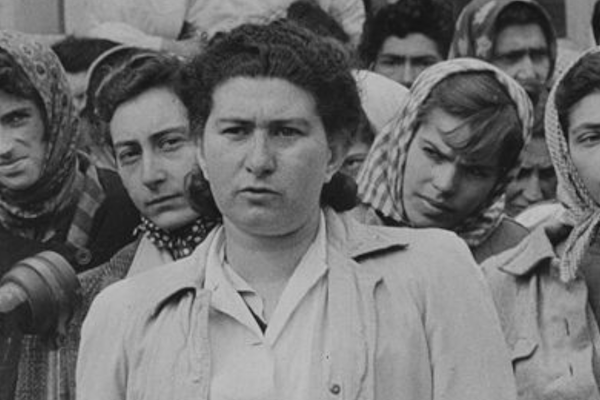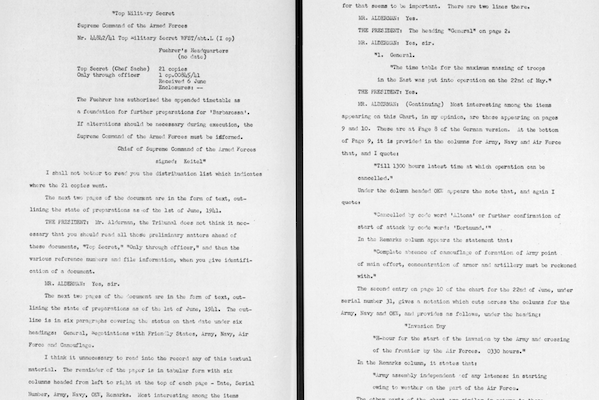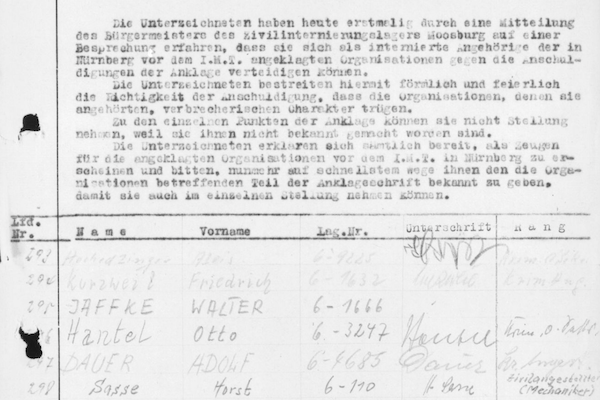The Taube Archive of the International Military Tribunal (IMT) at Nuremberg, 1945-46 archival collection provides access to a digital version of Nuremberg IMT courtroom proceedings and documentation, including evidentiary films, full audio recordings of the proceedings, and approximately 250,000 pages of digitized paper documents. These documents include transcripts of the hearings in English, French, German and Russian; written pleadings; evidence exhibits filed by the prosecution and the defense; documents of the Committee for the Investigation and Prosecution of Major War Criminals; the judgment. All 9,920 collection items are searchable and viewable in digital form.
Explore the collection

Media type
Introduction to the International Military Tribunal at Nuremberg
The International Military Tribunal at Nuremberg was the first international criminal trial and, to this day, it remains the most prominent. The “trial of the century” was convened in the aftermath of the collapse of the Third Reich, the destruction caused by World War II, and the horror of the unparalleled atrocities committed by the Axis Powers. Retribution for these crimes was declared as one of the principal Allied war aims as early as 1941, and by 1943, the Allies had decided to set up a commission to gather evidence of Nazi crimes. In August 1945, the four Allied Powers of France, the Soviet Union, the United Kingdom and the United States (the “Four Powers”) signed the London Agreement, paving the way for the prosecution of major war criminals before the IMT.
The choice of Nuremberg as the location for the trial was symbolic. The city lay in ruins, but the courtroom had survived the Allied bombings almost intact: Europe was going to be rebuilt by the rule of law. The very name “Nuremberg” was also evocative of Nazi Germany itself. It was here that the infamous 1935 laws were promulgated and that the Nazi party's annual mass rallies were staged. It should be noted that the official seat of the Tribunal was Berlin, where the opening session was held.
The trial opened on 20 November 1945 and, after 403 sessions held over 216 days, the Tribunal delivered its verdict on 1 October 1946.
Introduction adapted from the booklet The Nuremberg Trial Archives prepared by the Registry of the International Court of Justice, edited for length and clarity.
Impact and legacy
The IMT contributed to the definition of war crimes and the outlawing of wars of aggression. Among other significant contributions, it enabled the formulation of the offenses listed in count four of the indictment, namely crimes against humanity, and the prosecution of high-ranking State officials. It is now beyond dispute that an individual can be held to account under international law and that war crimes and crimes against humanity constitute criminal offenses under customary international law. The precedent created by the Nuremberg Trial was a significant step for the international community and a foundation of international criminal justice.
Direct descendants of the IMT, ad hoc courts, such as the International Criminal Tribunal for the former Yugoslavia (ICTY) and the International Criminal Tribunal for Rwanda (ICTR), and hybrid courts, such as the Special Court for Sierra Leone (SCSL), the Extraordinary Chambers in the Courts of Cambodia (ECCC) and the Special Tribunal for Lebanon (STL), have been founded since the 1990s, and the International Criminal Court, a permanent tribunal, was established in 1998. Besides endowing these modern tribunals with legitimacy and lists of crimes, the IMT also provided a basis from which the procedure of these tribunals evolved. Some 50 years after the Nuremberg Trial, Louise Arbour, Prosecutor of the ICTY, remarked: "Collectively, we are linked to Nuremberg. We mention its name every single day."
Acknowledgments
We are grateful for the collaboration with the Library of the International Court of Justice for use of the content in this website, and with the Taube Philanthropies for the generous gift that made this project possible. We gratefully acknowledge the generosity of United States Holocaust Memorial Museum (USHMM), which shared the results of their cataloging efforts, a portion of which is included in this digital archive. The involvement of the ArcLight open-source community during the development process and subsequent collection release of this site has also been of significant assistance.
We also wish to thank our Stanford University colleagues for the work and effort put into the Nuremberg Trial Archives project and site. In particular, we want to thank: our partner, the Center for Human Rights & International Justice, for leadership, curatorial and subject specialist expertise; Stanford Libraries' Special Collections staff for their assistance utilizing ArchivesSpace; the Libraries' curators and bibliographers for support and outreach; the Stanford Media Preservation Lab for assistance with accessioning, captioning and transcripts; the Libraries' Digital Library Systems & Services (DLSS) Access & Discovery team for building out the site's technical capability, including extensive data work and design; the DLSS Product & Service Management team for numerous points of support and assistance; and the DLSS Operations team for ongoing site maintenance and help with back-end, server-side issues.
We thank all of our colleagues in the aforementioned institutions,
Prof. David Cohen, Director of the Stanford Center for Human Rights and International Justice
Michael A. Keller, University Librarian
Tom Cramer, Associate University Librarian, Director, Digital Library Systems & Services, and Chief Technology Strategist

